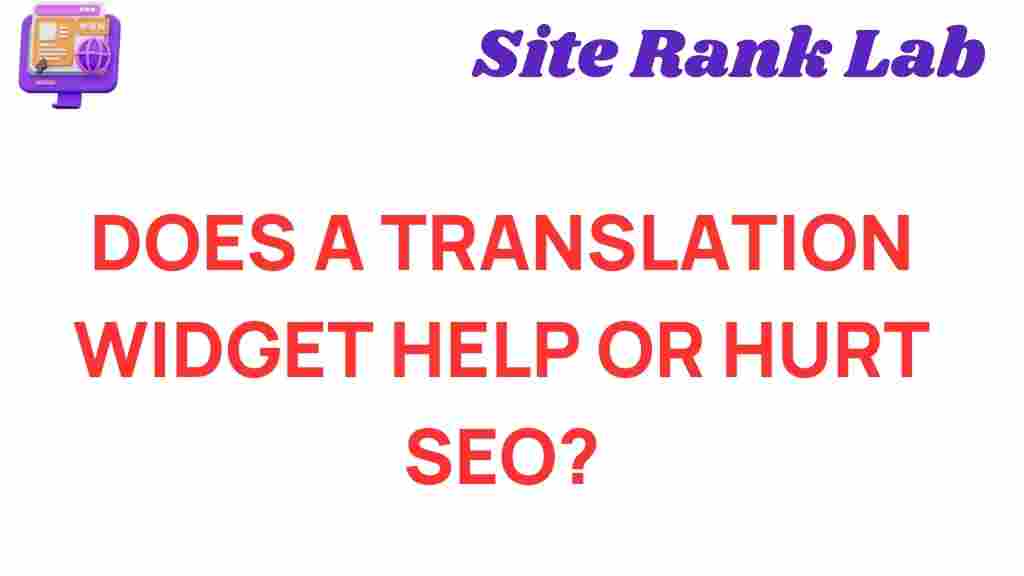Do Translation Widgets Enhance or Hinder Your SEO Strategy?
In an increasingly globalized digital landscape, businesses are keen on reaching a wider audience. One tool frequently employed in this quest is the translation widget. These widgets promise to make websites accessible to users who speak different languages, enhancing user experience and expanding market reach. However, the impact of translation widgets on your SEO strategy is a topic of ongoing debate. In this article, we will explore how translation widgets can affect your website optimization, user experience, multilingual content, search rankings, and overall digital strategy.
Understanding Translation Widgets
A translation widget is a tool that allows users to convert the content of a webpage into their preferred language with just a click. These widgets often come in various forms, such as drop-down menus or floating icons, and they utilize automated translation services to provide instant translations.
Benefits of Translation Widgets
Translation widgets can offer several advantages, including:
- Enhanced User Experience: Providing content in multiple languages can significantly improve the user experience for non-English speakers.
- Increased Accessibility: A translation widget makes your website more accessible to a global audience, catering to users from diverse linguistic backgrounds.
- Potential for Higher Engagement: By offering multilingual content, you can increase visitor retention and engagement on your website.
How Translation Widgets Affect SEO
The relationship between translation widgets and SEO is complex. While these tools can enhance user experience and accessibility, they can also pose challenges that may hinder your search rankings. Here’s a closer look at both sides.
Positive Impacts on SEO
When used correctly, translation widgets can positively impact your SEO strategy:
- Broader Audience Reach: By translating your content, you can attract a larger audience, leading to increased traffic and potential conversions.
- Enhanced User Engagement: A better user experience can lead to lower bounce rates and higher dwell time, both of which are favorable signals to search engines.
- Improved Brand Loyalty: Offering content in multiple languages can enhance brand loyalty and encourage repeat visits, which is beneficial for website optimization.
Negative Impacts on SEO
On the flip side, translation widgets can also create hurdles for your SEO strategy:
- Quality of Translations: Automated translations are often inaccurate, which can result in poor-quality content that may confuse or frustrate users.
- Duplicate Content Issues: If the same content is available in multiple languages without proper canonical tags, it can lead to duplicate content issues that harm your search rankings.
- Dependence on Third-Party Tools: Relying on external translation services can make it difficult to control the quality and consistency of your content.
Best Practices for Using Translation Widgets
To leverage translation widgets effectively while minimizing potential SEO pitfalls, consider the following best practices:
- Use High-Quality Translation Services: Whenever possible, opt for human translation services or high-quality machine translation to ensure accuracy.
- Implement hreflang Tags: Use hreflang tags to inform search engines about the language and geographical targeting of your content, helping to prevent duplicate content issues.
- Provide Dedicated Language Pages: Instead of relying solely on translation widgets, create separate pages for each language to enhance SEO and user experience.
Step-by-Step Process for Implementing Translation Widgets
If you decide to use a translation widget on your website, follow this step-by-step process:
Step 1: Identify Your Target Languages
Analyze your audience and determine which languages are most relevant to your business goals. This will help you select the right languages for your translation widget.
Step 2: Choose a Reliable Translation Widget
Research and select a translation widget that offers high-quality translations and integrates seamlessly with your website. Look for features like customization options and support for multiple languages.
Step 3: Integrate the Widget into Your Website
Follow the widget’s installation instructions to integrate it into your website. Ensure that it is easily accessible and visible to users.
Step 4: Test the Translations
Before going live, test the translations provided by the widget. Ideally, have a native speaker review the content to ensure accuracy and quality.
Step 5: Monitor Performance
After implementation, keep track of user engagement metrics and search rankings. Use tools like Google Analytics to measure the impact of the translation widget on your website’s performance.
Troubleshooting Common Issues with Translation Widgets
Even with careful planning, you may encounter some issues when using translation widgets. Here are common problems and how to address them:
Problem 1: Poor Translation Quality
Solution: If you notice that the translations are inaccurate, consider switching to a different translation service or supplementing the widget with human translators.
Problem 2: Duplicate Content Warnings
Solution: Ensure you are using hreflang tags correctly and consider setting up dedicated language pages to avoid duplicate content issues.
Problem 3: Low User Engagement
Solution: Analyze user behavior to identify potential issues. You might need to improve the quality of content or adjust the widget’s placement on your website.
Conclusion
In summary, whether translation widgets enhance or hinder your SEO strategy depends on how you implement them. While they can improve user experience, accessibility, and engagement, they also come with challenges that must be addressed to protect your search rankings and overall digital strategy. By following best practices and being mindful of the potential pitfalls, you can effectively incorporate translation widgets into your website and attract a broader audience.
For more insights on optimizing your website for multilingual content, check out this guide on SEO best practices. If you’re looking to enhance your digital strategy further, consider consulting with an SEO expert to tailor solutions to your specific needs.
This article is in the category SEO and created by SiteRankLab Team
